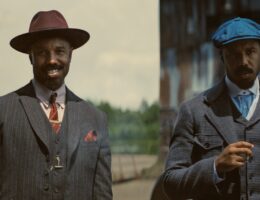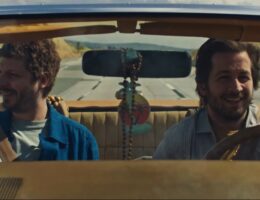Lamb (2021 | Iceland | 107 minutes | Valdimar Jóhannsson)
First, a warning: A24’s trailer for Lamb is quite possibly one of the best short films of the year. With ruthless economy, it instantly spins a mood of eerie dread on an isolated Icelandic sheep farm. Something is off and that something is a baby sheep that’s swaddled in a barn and brought into the house by a wide-eyed and shell-shocked Noomi Rapace. A host of other animals are unsettled; a houseguest looks on in caring confusion. Then Hilmir Snær Guðnason, of many excellent flannels and fair isle sweaters, gives a beatific paternal smile. There’s an adorable lamb in cute clothes and a flower crown. Then Beach Boys’s “God Only Knows” drops in and sends the whole thing straight to the moon as scenes of escalating tension, incongruous tenderness, and so many angry sheep flood the frame. It’s two minutes of electricity in a bottle.
Valdimar Jóhannsson’s actual 107 minute film didn’t stand a chance. This is not to say that this year’s entry in the odd trend of prestige barnyard animal-named films (Pig, Cow, Lamb, in that order) is without merit, it’s just on a fully different planet from the promotional cut that promised something akin to Black Philip from the VVitch going on a spiritual retreat to Midsommar island. It’s fine for these two things to co-exist.
As for the film itself, it’s a meditative fable of mourning set — aside from an ominous Christmas Even intro — in the near-permanent daylight of a remote Icelandic summer. With the help of their very good border collie, Dog, husband and wife María (Rapace) and Ingvar (Guðnason) sustain a mid-sized farm in the green foothills of epic mountains and picturesque rivers. Feeding the flock, driving the tractor, going about the business of keeping the operation afloat. It’s a lot of work and they go about it good-naturedly, but it’s clear that the constant labor has left them hollowed. One of their few conversations involves time travel: he says he’s in no hurry to see the future; her comment about being more interested in going to the past suggests that they’ve suffered an unspecified tragedy.
Much of the movie plays without much in the way of spoken dialogue or action, allowing the widescreen scenery and cool blue light of Icelandic summer to take center stage. Long takes observe the couple going about their chores, sleeping through sunny nights, and repeating. Eventually, amid a seemingly normal lambing season, one baby sheep strikes their fancy. A wordless exchange, conducted only through pointed glances, marks their decision to bring that particular adorable lamb into the house, name it Ada, treating her as their child. It’s a decision that the never discuss, but is one that brings a sense of happiness into their quiet lives.
They live alone; so there are no other humans to question their decision even as the housecat looks on suspiciously, Dog isn’t sure what to make of it, and the creature’s birth mother occasionally nags at the window. For a time, her bleats are the only source of distress for this happy little family. María’s angry responses and occasional haunted dreams presage looming acts of violent self-preservation yet to come, but a little mid-summer madness from a new mother is to be expected.
Many summers seemingly pass before another human enters their happy little cocoon, in the form of Ingvar’s older, perpetually indebted, brother who crashes in the barn after a falling out with some rocker friends. His appearance and surprise at the state of their homestead, even expressed with utmost Nordic reserve, also jars the audience out of our spell. Are these narrator reliable? Are we seeing what they’re seeing? Did I really see what I thought I just saw? Wait, how many years can a young sheep sleep in a child’s crib? It’s probably best that you watch to find these answers for yourself.
Rapace is great at embodying this shell of a person, desperate for better times. With few words, she sells the resilience and desperation as well as the absurd embrace (literally and figuratively) of this strange new daughter. Guðnason, too, is convincing as the sad dad who’s ready to smile again. As good as they are, they’re playing various forms of empty-headed: grief-stricken or blinded by happiness. The most impressive performances are from the many untrained animal actors, their trainers, and the patient camera people who pull expressive turns from a whole flock of sheep, an incredulous cat, and a dog who seems to be several steps ahead of them all. There’s a lot of void to fill, emotionally, so it’s good that they have a whole farm.
With each passing chapter — the film has three — it remains visually enchanting and grows ever more deeply weird. The incredible realization of the always lamb child is a triumph of mixing child actors, real animals, and maybe some puppetry through visual effects wizardry. Even when she’s unsettling, Ada is never not adorable, from her expressive eyes, soft face, and deep bench of trendily rustic scandinavian outfits. Even as her role in the family becomes more absurd and she toddles around the house and yard, you can see how they fall for her charms, even when their devotion to her causes them to miss the signs of looming danger (I didn’t either; the ending came far more swiftly than I imagined.) It’s not the kind of horror movie that they advertised, but it’s chilling nonetheless.
Lamb arrives in theaters on October 8.
Header image courtesy A24.




